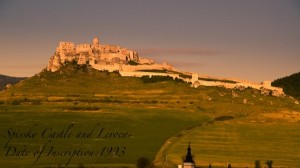 the Unesco World Heritage list of places of historical importance which should be preserved for future generations. EST Frontier Slovakia takes you on a journey through these sites of cultural importance and natural beauty, which reflect the diversity and richness of Slovak’s heritage.
Banská Štiavnica
the Unesco World Heritage list of places of historical importance which should be preserved for future generations. EST Frontier Slovakia takes you on a journey through these sites of cultural importance and natural beauty, which reflect the diversity and richness of Slovak’s heritage.
Banská Štiavnica
Over the centuries, the town of Banská Štiavnica was visited by many outstanding engineers and scientists who contributed to its fame. The old medieval mining centre grew into a town with Renaissance palaces, 16th-century churches, elegant squares and castles. The urban centre blends into the surrounding landscape, which contains vital relics of the mining and metallurgical activities of the past.
 Bardejov
Bardejov
Bardejov is a small but exceptionally complete and well-preserved example of a fortified medieval town, which typifies the urbanisation in this region. Among other remarkable features, it also contains a small Jewish quarter around a fine 18th-century synagogue.
Spišský Hrad 
Spišský Hrad has one of the largest ensembles of 13th and 14th century military, political and religious buildings in eastern Europe, and its Romanesque and Gothic architecture has remained remarkably intact. Levoča was an important military training ground during the Great Moravian period (9th century). The remains of various built structures in the present town indicate the presence of a community in the 11th and 12th centuries.
 Vlkolínec
Vlkolínec
Vlkolínec, situated in the centre of Slovakia, is a remarkably intact settlement of 45 buildings with the traditional features of a central European village. It is the region’s most complete group of these kinds of traditional log houses, often found in mountainous areas.
The Wooden Churches
The Wooden Churches of the Slovak part of Carpathian Mountain Area inscribed on the World Heritage List consist of two Roman Catholic, three Protestant and three Greek Orthodox churches built between the 16-18th centuries. The property presents good examples of a rich local tradition of religious architecture, marked by the meeting of Latin and Byzantine cultures. Interiors are decorated with paintings on the walls.
 Caves of Aggtelek Karst and Slovak Karst
Caves of Aggtelek Karst and Slovak Karst
The variety of formations and the fact that they are concentrated in a restricted area means that the 712 caves currently identified make up a typical temperate-zone karstic system. Because they display an extremely rare combination of tropical and glacial climatic effects, they make it possible to study geological history over tens of millions of years.
 Primeval Beech Forests of the Carpathians and the Ancient Beech Forests of Germany
Primeval Beech Forests of the Carpathians and the Ancient Beech Forests of Germany
The Ancient Beech Forests of Germany, represent examples of on-going post-glacial biological and ecological evolution of terrestrial ecosystems and are indispensable to understanding the spread of the beech in the Northern Hemisphere across a variety of environments. The tri-national property is now to be known as the Primeval Beech Forests of the Carpathians and the Ancient Beech Forests of Germany (Slovakia, Ukraine, Germany).
If you are interested in our UNESCO tour or have any questions, do not hesitate to contact us at info@enjoyslovakiasoul.com or by phone: +421-904 292 468.


















